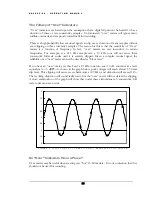
A D 2 4 0 2 - 9 6 - O P E R A T I N G M A N U A L
illuminated. Typically, the AD2402-96 can operate for 1-hr with the red LED illuminated before
the green LED will turn off. However, prolonged and/or frequent deep discharge cycles
(operation with the red LED on) will shorten the lifetime of a lead-acid battery. Lead-acid
batteries should be recharged after every use, and should be stored in a cool location, fully
charged.
“Input Level” Switch
This rotary switch adjusts the sensitivity of the analog inputs. The numbers (from +24, down to
+14) indicate the level (in dBu) at which a full-scale digital code will be reached. At “+24” the
converter will clip when the analog input reaches or e24 dBu. At “+14”, the converter
will clip when the analog input reaches or e14 dBu.
The “Input Level” switch should be set so that the AD2402-96 will clip 3 to 6 dB
before
the
microphone preamplifier. For example, if your microphone preamp has a maximum output level
of +24 dBu, then set the switch to “+20”. This will reserve 4 dB of headroom in the preamplifier.
If too much headroom is allowed in the microphone preamplifier, noise from the preamp may
reduce the dynamic range of your recording. If no headroom is provided, the microphone
preamp may add distortion to your recording.
Set the “Input Level” switch to match the performance of your preamp. Do not use this switch to
adjust levels during a recording. Instead, use the gain control on your microphone preamp. This
switch is used specifically to calibrate the AD2402-96 to a line level source, mixing console or
microphone pre-amp. It is NOT intended as a gain control for adjustment during a recording
session. Set the switch in accordance with your pre-amp or mixer before beginning the recording
session.
+24 dBu is a very hot level and is often only available at the output of high quality microphone
preamplifiers. Some battery operated microphone preamps cannot a24 dBu without
clipping, and will require setting the AD2402-96 to a lower clip point (typically “+20” or “+18”).
Use the “+14” setting for unbalanced inputs. Some consumer grade devices are not capable of
achieving even +14 dBu levels without clipping. These low-level unbalanced outputs are not a
good match for the performance of the AD2402-96 but can be connected through an external
balancing interface amplifier if necessary.
All preamplifiers have an intrinsic noise floor that is set by basic physics. The contributing
elements are the source impedance of the microphone, usually between 50 and 200 ohms, the
noise of the first stage of the preamplifier, the noise of second fixed gain stage, and the noise of
the output stage.
A preamplifiers dynamic range is defined by the difference between this intrinsic internal noise
level and the peak output clip point of the preamp. If the clip point is reduced to say + 12 dBu,
and nothing short of miraculous is done to reduce the second and third stage noise of the
preamplifier, the dynamic range of the pre-amp will be limited to much less than the AD2402-96.
11












































